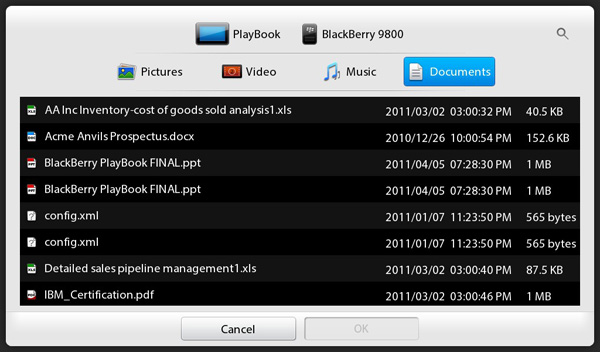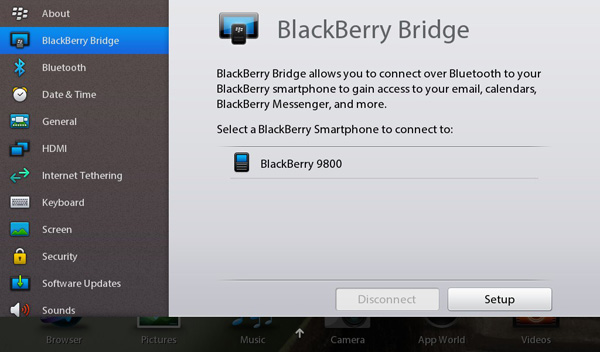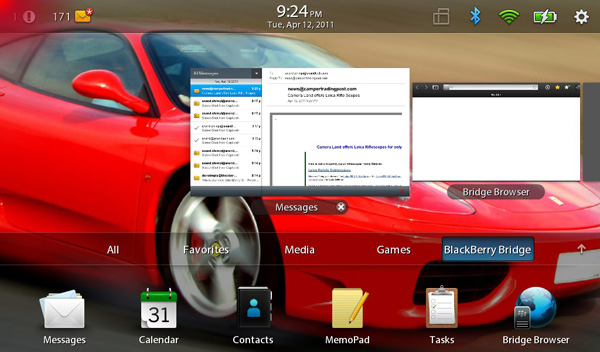The BlackBerry PlayBook Review
by Anand Lal Shimpi on April 13, 2011 9:00 PM EST- Posted in
- Tablets
- Smartphones
- RIM
- BlackBerry
- PlayBook
- Mobile
BlackBerry Bridge
The first era of the mobile revolution was about apps. Quantity, quality, method of delivery, everything that related to the apps on these devices is what really helped accelerate adoption of platforms like Android and iOS. While we're not quite done with the first era, the next era will be one of synergy between devices. Today there's simply no good way to seamlessly share all of your data (both static and active) among all of your computing devices (PC, tablet and smartphone). Cloud services help bridge the gap but what about some of the basic use cases? Let's say I've got a few tabs open in Chrome on my PC and I decide to take a break and read those websites on my tablet. There's no way to quickly take my current operating environment with the apps/tasks I've got open and transition them to another device.
Everyone who is anyone in the mobile space is working on device synergy, although very few attempts have been demonstrated publicly. HP's touch-to-share is an early example of synergy between devices, although it's presently limited to sharing URLs between webOS phones and the TouchPad. You can see how HP is in a good position however to extend that sort of synergy to its desktops as well. The same goes for Apple. Google wouldn't have too hard of a time doing it, assuming you're running mostly web apps on your PC and store state in the cloud.
RIM's first attempt at device synergy targets its loyal (whether forced or by choice) customer base: BlackBerry users. In the enterprise, the BlackBerry does a handful of things extremely well. The features are apparently attractive enough to actually force some users to carry two smartphones: an iPhone/Android phone for personal use and a BlackBerry for work.
The PlayBook solution is called BlackBerry Bridge. At a high level it's a 256-bit AES encrypted link over Bluetooth between the tablet and any BlackBerry running OS 5.0 or later. This encrypted link is then used to manage data stored on the BlackBerry using the PlayBook. In essence, the PlayBook becomes a larger window into your BlackBerry.
To enable BlackBerry/PlayBook interoperability you have to do two things. First, on the PlayBook, go to the BlackBerry Bridge settings page and enable the option. You'll be taken through steps to get the Bridge app onto your BlackBerry and finally pair the two devices. RIM just enabled Bridge support within the past 24 hours so the process is a bit more complicated for reviewers than it will be for customers. While an end user should be able to just scan the QR code displayed on the PlayBook with a BlackBerry, I had to login to RIM's beta site and manually download the app as well as jump through a few additional hoops.

The pairing process is pretty simple, pretty typical for a Bluetooth pair. You'll get a pin on both devices, make sure they match, hit go and you're all synced up.

Once paired, you can lock your BlackBerry and set it aside. The PlayBook now gives you full access to messages, calendar, contacts, memos, tasks and even your BIS/BES connection for browsing the web. Again, the link between the BlackBerry and PlayBook is 256-bit AES encrypted so you don't sacrifice any security in doing this.
The default PlayBook home screen has four categories for apps: All, Favorites, Media and Games. Enabling Bridge adds a fifth category: BlackBerry Bridge. All apps in this category pull their data from your BlackBerry and don't store anything on the PlayBook itself. Once you end the Bridge session, all data goes away. Even when you're using the PlayBook anything that comes from your BlackBerry is stored temporarily in memory and encrypted during its stay on the tablet. RIM's goal here is to allow the PlayBook to be introduced into a secured enterprise environment without compromising that security.
All internet/intranet data you access through a BlackBerry Bridge app goes over your BlackBerry internet connection, which means it all goes through BIS/BES and is thus fully encrypted. There's obviously a performance penalty, but if you need the added security, it's there.
BlackBerry Bridge apps are all choppier than regular PlayBook apps, something you notice even when you scroll over them in the task switcher. Scrolling over PlayBook apps is typically pretty smooth but get to the first active Bridge app and the animation frame rate drops a bit.
BlackBerry Bridge Messages
By default the PlayBook has no thick email client, something RIM will rectify this summer in an update to the PlayBook OS. BlackBerry Bridge however gives you full access to all messages received by your BlackBerry via the Messages app.
The Messages UI is pretty standard for a tablet email client. There are two columns, one for your inbox and one for the currently selected message. In portrait mode only one column is visible at a time.
You can do most of the basics from the Messages app: search, compose, delete, forward, reply, flag and move. Curiously absent is the ability to mark all items as opened like you can on a BlackBerry. You can go into multiple-selection mode just like on Android/iOS and mark items as opened that way, but there's no mark all option unfortunately.

You can send attachments via Bridge from either the PlayBook or BlackBerry, but you can't open them currently
Selecting multiple items in the Messages app is considerably slower than other aspects of the PlayBook UI. Given how fast and smooth everything else is, any sluggishness is that much more pronounced.
Calendar, Contacts, MemoPad and Tasks
The Bridge Calendar app isn't particularly beautiful, but it's functional. You can create and view appointments, which are again stored only on your BlackBerry. Unfortunately any reminders set in your calendar don't currently propagate to the PlayBook, they'll appear on your BlackBerry but not on the tablet. RIM clearly has work to do here.
The Contacts, MemoPad and Tasks apps are all self explanatory. Any data you create/access here lives solely on the BlackBerry, the PlayBook is simply a more user friendly viewport into your work world.
The notification problem exists for the Tasks app as well. You can have a reminder set for a task but you'll only be notified on your BlackBerry.
BlackBerry Bridge Browser
Remember that all Bridge apps use your BlackBerry's encrypted internet connection to get to the outside world. If you need that added layer of security for web browsing, just fire up the Bridge Browser.
The Bridge Browser app itself is just as functional as the standard PlayBook browser. You can even run the PlayBook's browser and the BlackBerry Bridge browser in parallel, using one for unencrypted web traffic and the other when you need additional security. The only difference between the two browsers is what path your packets take: WiFi or Bluetooth-to-BlackBerry-radio.












77 Comments
View All Comments
PeeluckyDuckee - Thursday, April 14, 2011 - link
The Android platform UI is very unpleasant to work with and an eye sore, looks like something from yesteryears. The hardware supporting it is slow and lag is quite apparent, whether that is a software or hardware issue doesn't matter as in the end the user experience leaves a bitter taste in my mouth.Apps is a non issue imo as time goes on it will slowly come. The major titles will be available cross platform. I buy it for what it offers me now, I don't rely solely on what will come later.
The QNX UI is very smooth and true multitasking is available. 7" form factor is perfect for my needs. Battery life is less of an issue as it will be rarely transported, but if I do need it for extended periods outside of the house it'll be either plugged into the car charger, into my USB battery pack, or plugged into the USB charger in the plane.
5" is too small and 12" is too big for me, so I will eventually have the best of both worlds and juggle between the 7" Playbook and the 10" iPad 2. Both are priced cheap enough that it doesn't have to be mutually exclusive, considering how much laptops/desktops/tablets used to cost it's a no brainer.
bplewis24 - Thursday, April 14, 2011 - link
If you expected anybody to read your post, you shouldn't have destroyed your credibility with your opening sentence.Stuka87 - Thursday, April 14, 2011 - link
It seems like many of the Tablets (and even phones in some cases) these days are being rushed out. I can understand the rush to get a product to market to try and grab market share early before competing products get to well entrenched, but coming out with a product that is short of features seems like it could be just as bad.Take WP7 for instance, in general it has some good concepts, but is missing a lot of features, as well as a usable browser. Updates will fix this, but the initial reviews have hurt it I think.
Then you have Android 3.0 which only works on Tablets, and has issues with them as it is. It was definitely rushed out to try and grab some market share before Apple gets much more entrenched.
Then we have this device, which has some cool features, but many features that will not be available until sometime this summer.
I realize the companies have to found a balance between getting a product out and finishing it, but it seems in some cases its cut too close. And we end up with a product that could have been great if only it had spent a bit more time in development.
On a side note, I do NOT like the screen on this device. Its way to narrow. I would not enjoy having a screen with that aspect ratio.
xype - Thursday, April 14, 2011 - link
"It seems like many of the Tablets (and even phones in some cases) these days are being rushed out."Just shows how much of a lead Apple actually has with the iPad. Most of the stuff out by now can't even compete with iPad 1, much less 2.
And even _when_ they get some small details right, it's the overall experience that makes the iPad's competition suffer.
Also, I quite like iPad's 4-finger-gestures for multitasking—too bad you have to set up your iPad as a development device to activate the preference in the first place…
medi01 - Thursday, April 14, 2011 - link
No "confusing" memory card slots, eh?melgross - Thursday, April 14, 2011 - link
The problem with memory slots are that what happens to your data and apps when you want to add another card? Usually you can't do that, you're stuck with what you've got, because part of the app resides on the card, and the rest in built in memory. So show lose the card, or it gets damaged, and you're in trouble.Manufacturers are using slots to make their devices look less expensive,
Urging the responsibility on the buyer to spend the extra cash to expand their memory. The problem is that most people, even those who are technically adept (or who pretend to be), don't realize that cheap Flash memory cards are a lot slower than the Flash inside their device. In order to keep the speed, they've got to buy more expensive memory cards. They haven't really saved much, if anything, if they do that. I'd rather pay upfront, and know that what I'm using is what I'm supposed to be using.
silverblue - Thursday, April 14, 2011 - link
The date format of the video of the dog is in YYYY-MM-DD format... sorry, I just enjoy seeing non-American date formats for once. :)It's a promising tablet design, but they've got a way to go before it can be a true competitor to the iPad 2. The lack of an e-mail client doesn't sit well with me, but the inclusion of 1080p High Profile H.264 support is excellent, and it's light.
Conficio - Thursday, April 14, 2011 - link
I'm usually not that interested in video in such devices, but your sample videos could really use some image stabilization.On such a large device that should be mandatory.
Griswold - Thursday, April 14, 2011 - link
An otherwise very interesting product suffers from two shortfalls:1) Too small. As mentioned in the article, its a matter of what you do, where you do it and personal preference. Personally I prefer the 9-10" size.
2) Its far from finished. Every other thing needs tning, tweaking, polishing or is completely missing. Why bother handing out review units, RIM? You're just damaging your products reputation!
GnillGnoll - Thursday, April 14, 2011 - link
"I've complained in the past about the input problem on tablets, and I do believe it's actually worse on the PlayBook thanks to its cramped screen resolution."While higher resolution might help a little by allowing text to be slightly smaller while keeping it legible, this is really about area not resolution. You can't make the on-screen keyboard or address bar much smaller physically without significantly affecting their touch usability.